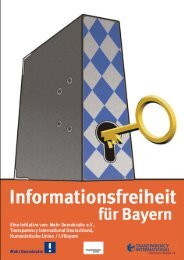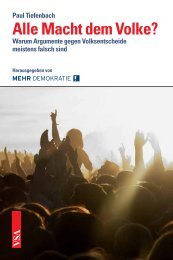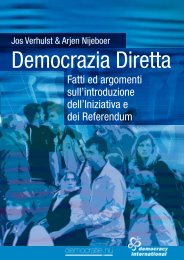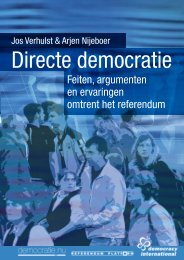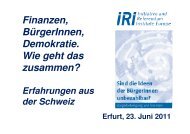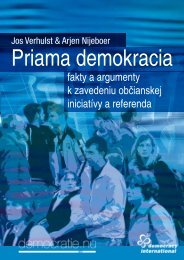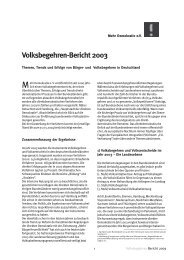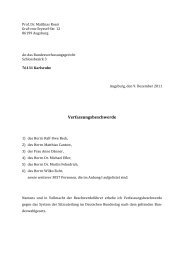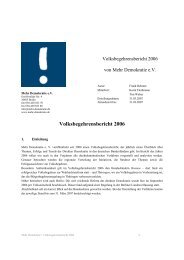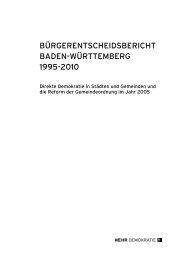Facts and Arguments about the Introduction of Initiative and ...
Facts and Arguments about the Introduction of Initiative and ...
Facts and Arguments about the Introduction of Initiative and ...
You also want an ePaper? Increase the reach of your titles
YUMPU automatically turns print PDFs into web optimized ePapers that Google loves.
• People who launch a citizens’ initiative can call upon certain<br />
government services at an early stage. They can be assisted<br />
by <strong>the</strong> Legislative Counsel in getting <strong>the</strong> wording <strong>of</strong> <strong>the</strong><br />
proposal into <strong>the</strong> proper legal form. The subject prepared<br />
in this way is <strong>the</strong>n passed to a senior judge, <strong>the</strong> attorney<br />
general, who composes <strong>the</strong> <strong>of</strong>ficial title <strong>and</strong> <strong>the</strong> summary <strong>of</strong><br />
<strong>the</strong> proposal. The title <strong>and</strong> summary are important because<br />
<strong>the</strong>y appear in <strong>the</strong> <strong>of</strong>ficial ballot pamphlet. Fur<strong>the</strong>rmore, in<br />
cooperation with <strong>the</strong> Ministry <strong>of</strong> Finance, among o<strong>the</strong>rs,<br />
an analysis is made <strong>of</strong> <strong>the</strong> fiscal consequences <strong>of</strong> <strong>the</strong> new<br />
proposal. This all takes four to six weeks. The proposal can<br />
<strong>the</strong>n be circulated for <strong>the</strong> collection <strong>of</strong> signatures.<br />
• All matters that are within <strong>the</strong> power <strong>of</strong> <strong>the</strong> state can be <strong>the</strong><br />
subject <strong>of</strong> a citizens’ initiative, thus including <strong>the</strong> budget,<br />
taxes, immigration, etc. There is only one formal requirement:<br />
<strong>the</strong>re must be unity <strong>of</strong> subject – a citizens’ initiative<br />
may not contain two unrelated subjects.<br />
• Both constitutional initiatives <strong>and</strong> statute law initiatives<br />
are possible. The signature threshold for <strong>the</strong> first <strong>of</strong> <strong>the</strong>se<br />
is equal to 8% <strong>of</strong> <strong>the</strong> turnout at <strong>the</strong> last election for <strong>the</strong><br />
state governor; for <strong>the</strong> second it is 5% <strong>of</strong> this turnout. The<br />
maximum collection period is 150 days. An approved constitutional<br />
initiative cannot be subsequently amended by<br />
<strong>the</strong> state’s house <strong>of</strong> representatives, but only by a new referendum.<br />
Approved statute law initiatives, however, can be<br />
amended by <strong>the</strong> state’s house <strong>of</strong> representatives.<br />
• Californian citizens’ initiatives are direct initiatives. In contrast<br />
to indirect initiatives, <strong>the</strong>se are not enacted through<br />
<strong>the</strong> parliament. The parliament, <strong>the</strong>refore, cannot launch<br />
a counter proposal against <strong>the</strong> citizens’ initiative. Citizens’<br />
initiatives are swiftly submitted to <strong>the</strong> ballot: if <strong>the</strong> formal<br />
thresholds are achieved in <strong>the</strong> summer, <strong>the</strong> citizens’ initiative<br />
will already be put to <strong>the</strong> vote in <strong>the</strong> November <strong>of</strong> that<br />
year. In principle, <strong>the</strong>re is only one election day every two<br />
years, to which a maximum <strong>of</strong> one additional voting day may<br />
sometimes be added. This means that <strong>the</strong>re are frequently<br />
very many citizens’ initiatives put to <strong>the</strong> vote on a single election<br />
day. These points, each <strong>of</strong> which differs from <strong>the</strong> Swiss<br />
system, are criticised by some supporters <strong>of</strong> direct democracy.<br />
According to <strong>the</strong>m, longer periods <strong>and</strong> <strong>the</strong> spreading out<br />
<strong>of</strong> citizens’ initiatives across several voting days each year are<br />
good for <strong>the</strong> public debate. The absence <strong>of</strong> a parliamentary<br />
process <strong>and</strong> a possible counterproposal provides <strong>the</strong> public<br />
with less information <strong>and</strong> fewer options.<br />
• A proposal that is approved by <strong>the</strong> public can never<strong>the</strong>less<br />
still be annulled by <strong>the</strong> law courts. The risk that a legislative<br />
proposal approved by referendum may none<strong>the</strong>less still be<br />
annulled by <strong>the</strong> courts is quite considerable: between 1964<br />
<strong>and</strong> 1990, this happened to 14 <strong>of</strong> <strong>the</strong> 35 citizens’ initiatives<br />
that achieved a majority in <strong>the</strong> ballot box. A successful citizens’<br />
initiative can thus see <strong>the</strong> results <strong>of</strong> long, hard work be<br />
lost in court. It is clear that <strong>the</strong> checking <strong>of</strong> <strong>the</strong> proposed legislation<br />
after <strong>the</strong> vote has been held is a distinct disadvantage<br />
<strong>of</strong> <strong>the</strong> Californian system. This problem could be elegantly<br />
solved by introducing an intermediate petitionary step: a citizens’<br />
initiative that has ga<strong>the</strong>red a relatively small number<br />
<strong>of</strong> signatures, for instance 10,000, acquires <strong>the</strong> right to a<br />
parliamentary debate on <strong>the</strong> proposal <strong>and</strong> to a check by a<br />
constitutional court. This provides <strong>the</strong> people submitting<br />
<strong>the</strong> citizens’ initiative with <strong>the</strong> right to <strong>the</strong>n revise <strong>the</strong>ir proposal<br />
in <strong>the</strong> light <strong>of</strong> <strong>the</strong> parliamentary debate. Moreover, <strong>the</strong><br />
early constitutional check prevents a discouraging legal defeat<br />
<strong>of</strong> <strong>the</strong> proposal after <strong>the</strong> entire referendum process has<br />
3<br />
taken place. The annulment <strong>of</strong> a proposal approved by <strong>the</strong><br />
people is bad for democracy: <strong>the</strong> people must not only have<br />
<strong>the</strong> final say, but <strong>the</strong>y must also see that <strong>the</strong>ir say is final. An<br />
annulment, <strong>of</strong>ten on formal grounds, creates <strong>the</strong> frustrating<br />
<strong>and</strong> frequently justified impression that a powerful elite still<br />
ultimately awards itself <strong>the</strong> final say.<br />
• The Ballot Pamphlet: three to six weeks before <strong>the</strong> vote<br />
– <strong>the</strong> same as in Switzerl<strong>and</strong> – <strong>the</strong> voters receive a booklet<br />
containing <strong>the</strong> essential documentation <strong>about</strong> <strong>the</strong> referendum.<br />
This booklet contains, in addition to <strong>the</strong> <strong>of</strong>ficial title,<br />
summary <strong>and</strong> analysis mentioned previously:<br />
• <strong>the</strong> complete text <strong>of</strong> <strong>the</strong> initiative;<br />
• arguments for <strong>and</strong> against from <strong>the</strong> supporters <strong>and</strong> opponents,<br />
which must be submitted four months before<br />
<strong>the</strong> vote. Supporters <strong>and</strong> opponents have <strong>the</strong> right to 500<br />
words; after ano<strong>the</strong>r two weeks, both sides can submit a<br />
fur<strong>the</strong>r text <strong>of</strong> no more than 250 words in response to<br />
<strong>the</strong> o<strong>the</strong>r party’s text;<br />
• a concise summary <strong>of</strong> <strong>the</strong> arguments from both sides.<br />
The fate <strong>of</strong> referendums in California is variable. Between<br />
1912 <strong>and</strong> <strong>the</strong> 1930s, <strong>the</strong> voters had to deal with an average<br />
<strong>of</strong> more than four referendums a year. In <strong>the</strong> 1950s, 1960s<br />
<strong>and</strong> 1970s, <strong>the</strong> citizens’ initiative was rarely used. The people<br />
had great faith in <strong>the</strong> representative system. In <strong>the</strong> 1960s,<br />
only nine initiatives in total were launched. However, <strong>the</strong>reafter<br />
<strong>the</strong> citizens’ initiative began to gain in popularity, when<br />
remarkably enough both progressive <strong>and</strong> conservative initiatives<br />
seemed to have chances <strong>of</strong> success. ‘Conservative’ initiatives<br />
included <strong>the</strong> introduction <strong>of</strong> <strong>the</strong> death penalty, via a<br />
referendum in 1972. In <strong>the</strong> same year, <strong>the</strong> environmental<br />
movement booked a huge success with a bill <strong>about</strong> protection<br />
<strong>of</strong> <strong>the</strong> coastal zone which was approved by referendum.<br />
Even <strong>the</strong> threat <strong>of</strong> a citizens’ initiative was sufficient to force<br />
certain important changes, such as <strong>the</strong> moratorium on nuclear<br />
power stations that was approved in 1976.<br />
In 1977-78, <strong>the</strong> notorious ‘Proposition 13’ initiative was drawn<br />
up, which called for a halt to <strong>the</strong> increase in tax on real estate.<br />
The preceding years had seen steep inflation taking hold <strong>and</strong><br />
<strong>the</strong> price <strong>of</strong> l<strong>and</strong> <strong>and</strong> houses rising even higher than <strong>the</strong> depreciation<br />
in <strong>the</strong> value <strong>of</strong> <strong>the</strong> dollar. The result was that average<br />
families were confronted with a double tax explosion. Local<br />
taxes that were linked to <strong>the</strong> value <strong>of</strong> <strong>the</strong>ir homes shot up.<br />
And <strong>the</strong> inflation caused <strong>the</strong>ir incomes to move into higher<br />
<strong>and</strong> higher tax brackets, without a commensurate rise <strong>of</strong> purchasing<br />
power in real terms. This mechanism provided <strong>the</strong><br />
state <strong>of</strong> California with 2.6 billion dollars extra income in<br />
1976. In 1977, <strong>the</strong> consensus increased in <strong>the</strong> Californian<br />
parliament for using <strong>the</strong> additional income to lighten <strong>the</strong><br />
burden <strong>of</strong> <strong>the</strong> small homeowners. However, <strong>the</strong> politicians<br />
just could not agree on a precise scheme. Democrats argued<br />
in favour <strong>of</strong> a scheme that mainly benefited people with lower<br />
incomes, while Republicans, such as Reagan, proposed<br />
measures that provided high earners with <strong>the</strong> most benefit.<br />
Nothing happened during <strong>the</strong> entire spring, <strong>and</strong> in July two<br />
conservative anti-tax activists, Howard Jarvis <strong>and</strong> Paul Gann,<br />
announced <strong>the</strong> launch <strong>of</strong> a citizens’ initiative. Their proposal<br />
made short shrift <strong>of</strong> <strong>the</strong> uncontrolled tax increases that were<br />
driving <strong>the</strong> small homeowners to despair. But Proposition 13<br />
had ano<strong>the</strong>r hallmark: it made no distinction between homes<br />
<strong>and</strong> businesses, but lumped all real estate into <strong>the</strong> same category.<br />
This meant that <strong>the</strong> proposal provided <strong>the</strong> business<br />
community with an enormous benefit, where <strong>the</strong>y had not<br />
even requested it. This aspect did not attract any attention



